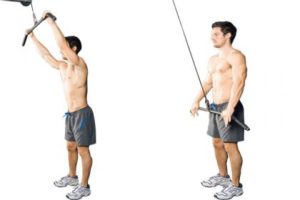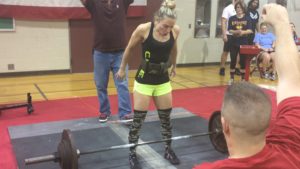Activate Your Lats for a Strong Deadlift
By Shane Lentz
C.O.R.E. Physical Therapy Intern
In a fairly recent article by Greg Nuckols, he sheds light on the importance of engaging the lats during the deadlift. The link to the original article is http://www.strongerbyscience.com/lats-in-the-deadlift/. If you are serious about bringing your deadlift number up, it is definitely worth a read.
The lats are a huge muscle group. They attach on the upper arm and insert all the way down onto your lower back and pelvis via the thoracolumbar fascia. Many people recognize that the lats play a role in pulling movements such as rows, pullups, or lat pulldowns, but most fail to realize their important role in spinal stabilization.
Spinal stabilization is key to an efficient, strong, and safe deadlift. Activating your lats properly during a deadlift will ensure spinal safety, improve your leverages, and ultimately make your deadlift stronger.
Quotes from the article are in bold and italics…
“I think the idea of “lat tension” accomplishes a much more basic purpose: Instead of the lats actually helping keep the spine extended, repositioning the scapulae and engaging the lats actually work to decrease the required spinal extension demands of the lift.”
When executed properly, the prime movers of a deadlift should be the glutes and hamstrings, with the core musculature contracting isometrically, acting as stabilizers. When the lats are engaged, spinal stabilization increasing, placing more demand on the glutes and hamstrings, the muscles we want to target, and less demand on the spinal muscles.
“Now, don’t expect a night and day difference from these little tweaks. You’ll maybe get a 3-5% decrease in hip and lumbar extension demands in total. That’s definitely enough to help you pull a bit more, but not a night-and-day difference. However, the place it would make a big difference is your upper back, helping you keep your thoracic spine extended (or at least keeping it from flexing too much).”
If you are a fan of powerlifting or have watched people deadlift before, you may have noticed that when many people fail a deadlift, their upper backs round and look like fishing poles or a scared cat. In some cases, this spinal flexion (rounding) is inevitable when doing a one rep max, but in most cases it can be prevented by simply engaging the lats better. With engaged lats, the bar is closer to your center of mass. Pulling from this position will help prevent any spinal flexion from occurring, allowing you to completely the lift more easily.
“Some useful cues for engaging your lats and depressing your scapulae are “put your shoulder blades in your back pocket” and “pull the bar into your shins”. Just simply focusing on pointing your elbows toward the wall behind you tends to help as well.”
Greg shared three simple cues here to help engage your lats when deadlifting. A practical approach would be to try all three of these and choose the one that works and feels the best for you. Another cue that I like for activating the lats is to imagine you are doing a straight arm pulldown. 
“This slight technique shift should also make the deadlift slightly more efficient, with a bit less front-to-back deviation in bar path. By engaging your lats, depressing your scapulae, and extending your shoulders a bit, you’re repositioning your body’s mass forward slightly, allowing the bar to shift backward a bit at the start of the pull, positioning the center of masses for both the bar and your body closer to the system’s center of gravity. As you extend your hips, your body’s center of mass won’t need to shift forward quite as much, so the bar won’t need to drift back quite as much, leading to a more linear bar path.”
In layman’s terms, Greg is telling us that activating the lats in the deadlift allows for a more efficient bar path. This is what we want. A more efficient bar path equates to a stronger deadlift. Take a look at Greg’s deadlift positioning in the photos above. In the top photo, his lats aren’t engaged. If he pulled from this position his hips would shoot up and the bar would come back in towards his shins before going straight up. In the bottom photo, his lats are activated. You can see that activating his lats brings the bar closer to his shins. Pulling from here will allow him
Key Takeaways
The lats are a huge muscle group that we need to take advantage of as a spinal stabilizer in the deadlift. Engaging the lats will result in the following:
- Less stress on the spinal extensors, allowing for the glutes and hamstrings to do the majority of the work.
- It will help prevent the dreaded “scared cat” (rounded back) deadlift.
- It will create a more efficient bar path, due to the bar being closer to your body and center of mass
- These factors combined = a stronger deadlift


